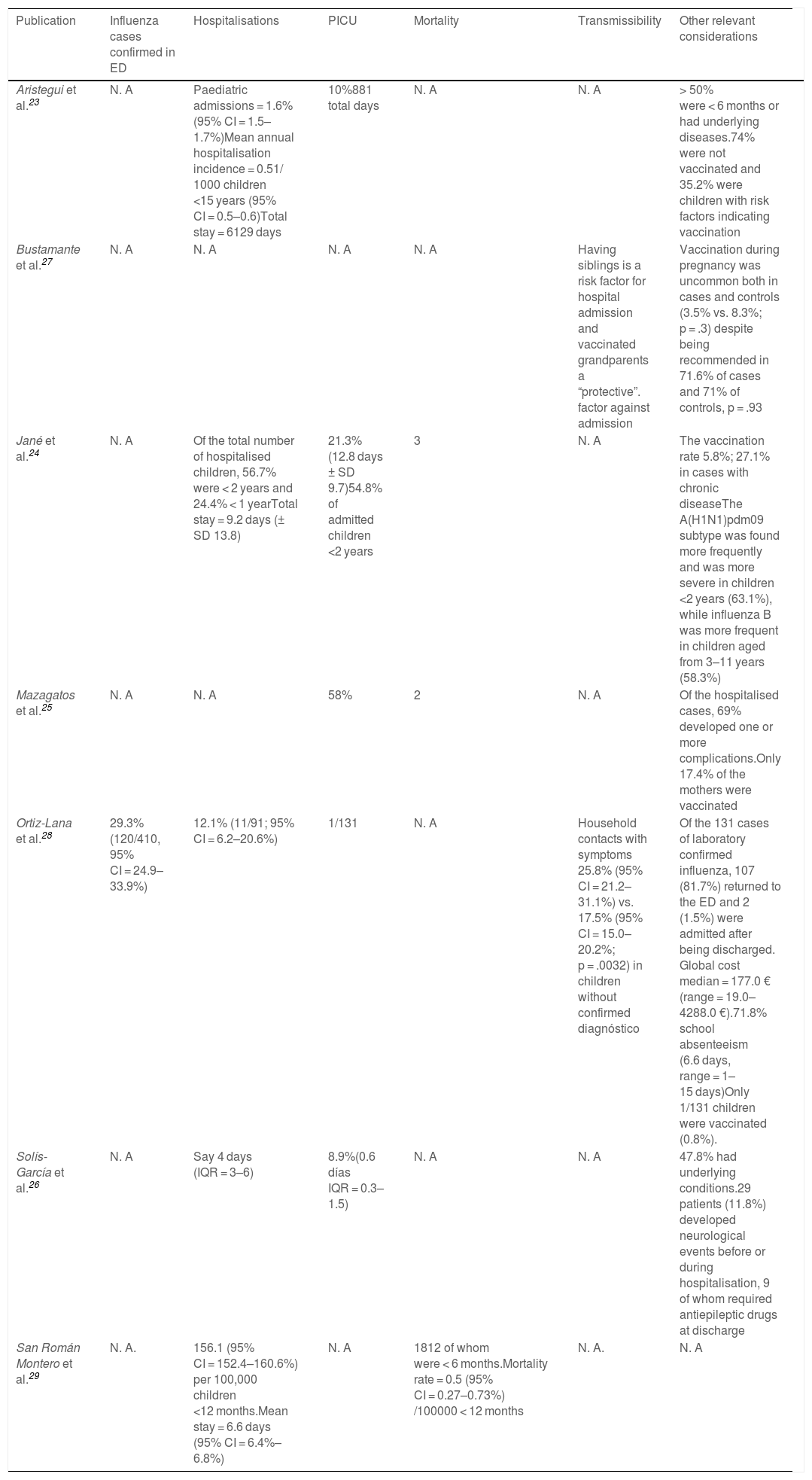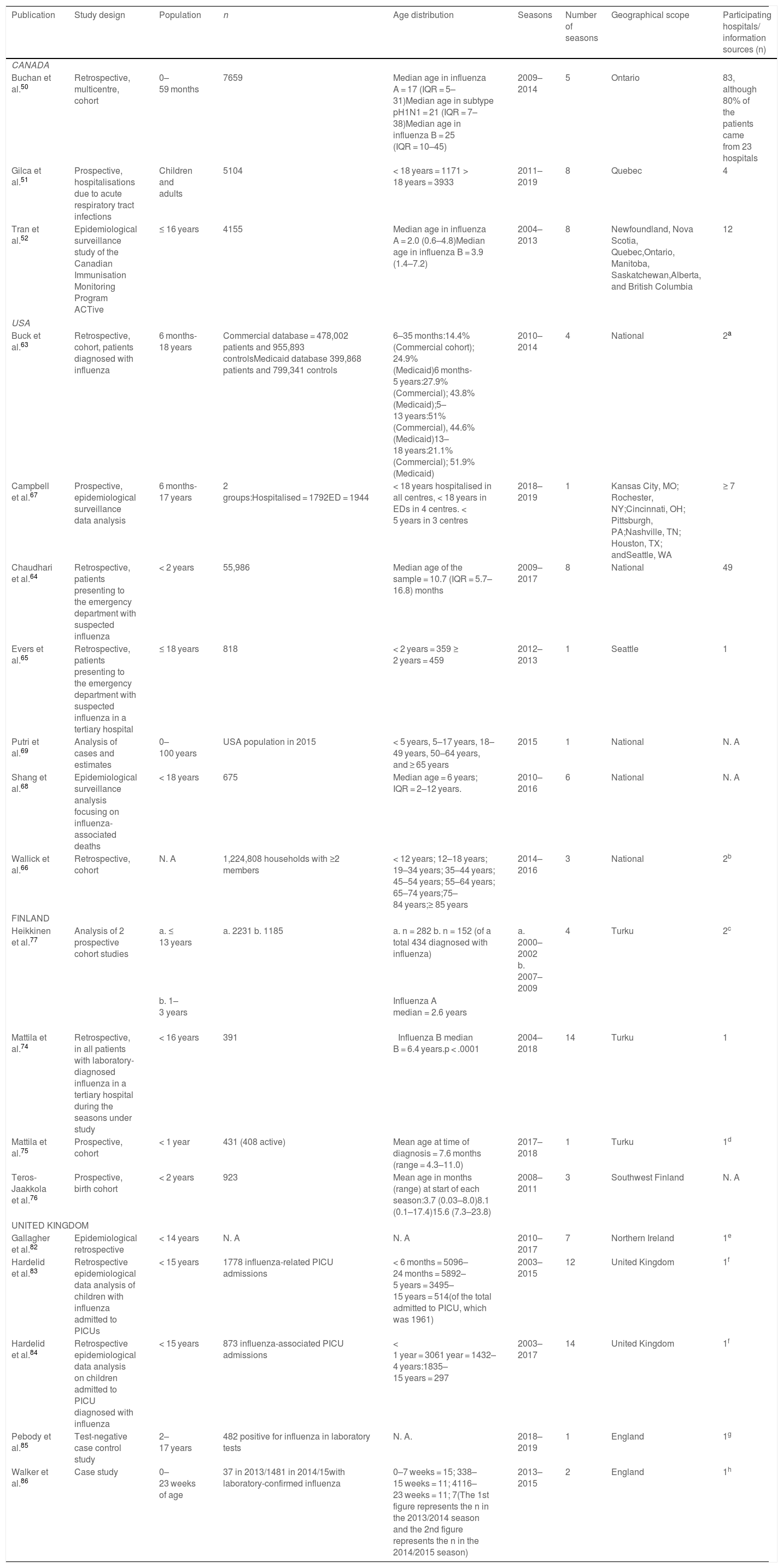The burden of influenza in the paediatric population is often underestimated by healthcare professionals and the general population, mainly due to poor perception of its clinical importance at the individual level and its health impact at the healthcare level. The aim of this review was to collect data on the burden of paediatric influenza in Spain and to compare them with data of countries where vaccination strategies for healthy paediatric populations have been implemented.
MethodsWe collected data on the burden of paediatric influenza in Spain through a systematic search of literature published between 2016–2021 (PRISMA methodology). We conducted a review of reports from the Spanish Influenza Surveillance System (SVGE) (2010–2011 to 2019–2020) and of international reports (from Canada, Finland, USA, and UK) through a systematic (2016–2021) and pragmatic search.
Results1366 articles were obtained from the systematic searches by country; 26 met the inclusion criteria. According to the SVGE (Spain's Influenza Surveillance System), those <15 years have the highest incidence of influenza per 100,000 population (cumulative-mean rate: 9457.9) compared to those ≥15 years (2285.6), and percentage of admission to the Paediatric Intensive Care Unit (PICU) greater than those >65 years (mean: 29.1% vs. 17.5%). Hospitalisation of severe cases per 100,000 population in children aged 0–4 years and those >65 years is similar (median: 20.2 vs. 28.4). Those aged <15 years have a higher incidence rate per 100,000 population (213.3), in contrast to those aged 15–64 years (21.9) and those aged ≥65 years (65.2). In countries with paediatric vaccination programmes (USA, Finland, and UK) the burden of influenza in children is reduced by 40%–74%, whereas 50%-93.5-% of cases presenting to the ED, hospitalised, admitted to PICU, or dying from influenza are unvaccinated.
ConclusionsThe burden of paediatric influenza in Spain includes a significant number of hospitalisations and PICU admissions and justifies the vaccination strategy recommended by the WHO since 2012. In countries with this recommendation, the vaccinated paediatric population is better protected against severe forms of influenza and potential benefits for reducing the burden of paediatric influenza in Spain can be extracted from their data.
La carga de gripe en población pediátrica suele estar infravalorada por los sanitarios y por la población general debido fundamentalmente a la escasa percepción de su importancia clínica a nivel individual como al impacto sanitario a nivel asistencial. El objetivo de esta revisión es recopilar datos sobre la carga de gripe pediátrica en España y contrastarlos con los de países en los que hay implementadas estrategias de vacunación de población pediátrica sana.
MétodosSe recopilaron datos de carga de gripe pediátrica en España mediante búsqueda sistemática de literatura publicada entre 2016–2021 (metodología PRISMA) y revisión de informes del Sistema de Vigilancia de la Gripe en España (SVGE) (2010–2011 a 2019–2020) e internacionales (de Canadá, Finlandia, EE. UU. y Reino Unido) mediante búsqueda sistemática (2016–2021) y pragmática.
ResultadosSe obtuvieron 1366 artículos de las búsquedas sistemáticas por países; 26 cumplían los criterios de inclusión. Según el SVGE, los <15 años presentan la mayor incidencia de gripe por 100,000 habitantes (tasa acumulada-mediana: 9457,9) respecto a los ≥15 años (2285,6); y porcentaje de ingreso en la Unidad de Cuidados Intensivos Pediátricos (UCIP) mayor que los >65 años (media: 29,1% vs. 17,5%). La hospitalización de casos graves por 100,000 habitantes en niños de 0–4 años y en los >65 años es similar (mediana: 20,2 vs. 28,4). Los <15 años tienen mayor tasa de incidencia por 100,000 habitantes (213,3), en contraste con la de los de 15–64 años (21,9) y los ≥65 años (65,2). En los países con programa de vacunación pediátrica (EE. UU., Finlandia y Reino Unido) se reduce la carga de la gripe en niños entre un 40–74% mientras que 50–93,5-% de los casos que acuden a Urgencias, son hospitalizados, ingresan en UCIP o fallecen por gripe no están vacunados.
ConclusionesLa carga de gripe pediátrica en España incluye un importante número de hospitalizaciones e ingresos en la UCIP y justifica la estrategia de vacunación recomendada por la OMS desde 2012. En países con dicha recomendación, la población pediátrica vacunada está más protegida frente a formas graves de gripe y de sus datos se extraen potenciales beneficios para disminuir la carga de gripe pediátrica en España.
Artículo
Comprando el artículo el PDF del mismo podrá ser descargado
Precio 19,34 €
Comprar ahora














